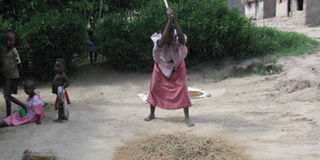Farmer's Diary: Taking good care of crops after harvest

Traditionally most threshing and shelling is done by beating with sticks, which is not that efficient. Also, harvested food crops are vulnerable to domestic animals. Photo by Micheal J. SSali.
If we do not take good care of our crops after harvesting them, we run the risk of losing them. One important step is to ensure that the crop is well dried before it is stored. A lot of moisture could lead to growth of mould and rotting or germination of the crops during storage.
Improperly dried crops may develop a bad taste and an unpleasant appearance and become unsuitable for human consumption. Some people keep moisture meters to determine crop dryness and the machines are perhaps the best for determining the moisture content in crops. They are normally battery powered, portable, and easy-to-use but they are expensive and beyond the capacity of most small scale farmers.
A group of farmers can, however, pool their savings and buy one. The method most of us use to determine dryness tends to be biting with our teeth, or shaking the crop as we listen to the sound made by the pods.
Most people, however, consider about nine days of proper sun drying as sufficient for a crop such as maize or coffee to be dry enough for safe storage.
Foreign objects
It is important to keep the crop free of all pieces of broken pods, sheath, and any grasses. They are not edible anyway, they take up space in the storage containers, and some of them attract pests. Moreover, if pesticides are to be used the pieces of grass and other foreign objects including stones will all be smeared with the preservative even if there is no need to preserve them.
However, care must be taken to minimise the loss of grain during threshing and removal of all foreign objects.
Since most threshing and shelling is done by beating with the use of sticks, it is safer to carry this out on a mat or tarpaulin to avoid contamination with soil and stones, especially in the case of tiny grain such as rice and millet. The tarpaulin and mat will also reduce the risk of the crop spilling on to the ground from where it might be hard to retrieve it.
Beating tends to cause mechanical damage on the grain which may give it a bad appearance in the shop or at the market and possibly prevent germination later, if it is planted.
It is good for the farmer to improvise sieves in form of wire mesh to separate grain from chaff.
Traditionally, some people in many African communities use locally made baskets to carry out winnowing, which in most cases exposes the farmer to inhaling dust and is rather tedious.
Moreover, it is usually not just dust and chaff that is blown away during winnowing but also a little of the grain itself, leading to some loss of the crop. Generally, the farmer has to appreciate that the harvested crop is vulnerable to pests, rodents, bad weather effects, domestic animals and birds, and even thieves. Therefore, safe storage of the crop has to be carried out with so many issues in mind. Is the grain protected from rain? Is it in a place that is closely and constantly monitored?
Correct application
Is it kept in a strong enclosure which cannot easily be opened by thieves? Is the floor where it is placed free from any moisture? If the grain is contained in bags, it is advisable to place the bags on wooden trays or closely laid logs? Keeping a cat in the home or clearing the bush and timely removal of rubbish from the compound will drive away rats and other rodents.
It seems impossible for an ordinary farmer to store grain over a long period, without any recourse to fumigation and the use of insecticides.
The insecticides for preserving grain are available in farmers’ shops but it has to be born in mind that they are poisonous, and yet they are to be used for preserving food crops to be ultimately eaten by humans or animals. Therefore care must be taken to ensure that they are correctly applied according to the manufacturers’ instructions and agricultural services extension providers.




